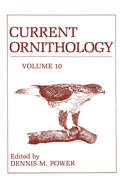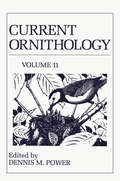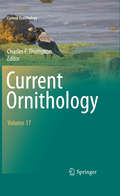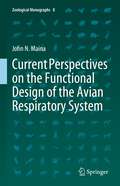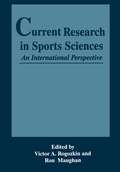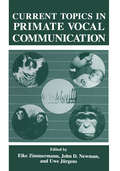- Table View
- List View
Current Ornithology (Current Ornithology #16)
by Val Nolan Jr. Charles F. ThompsonCurrent Ornithology publishes authoritative, up-to-date, scholarly reviews of topics selected from the full range of current research in avian biology. Topics cover the spectrum from the molecular level of organization to population biology and community ecology. The series seeks especially to review 1) fields in which abundant recent literature will benefit from synthesis and organization, 2) newly emerging fields that are gaining recognition as the result of recent discoveries or shifts in perspective, and 3) fields in which students of vertebrates may benefit from comparisons of birds with other classes. All chapters are invited, and authors are chosen for their leadership in the subjects under review.
Current Ornithology (Current Ornithology #12)
by D. M. PowerIn Volume 12, eminent international ornithologists further elucidate endocrinological correlates of mating strategies and hormones and reproductive behavior; assess the value of the ''brood reduction hypothesis'' in explaining ''the paradox of hatching asynchrony''; and explore the validity and sensitivity of growth bands in feathers as an indication of nutritional condition and the use of feather banding in studying growth. Chapters are well supported with charts, maps, schematic diagrams, and photographs. Current Ornithology is the only English-language publication currently devoted exclusively to extensive reviews and synthesis of topics pertaining to all aspects of the biology of birds. Chapters fall under such diverse rubrics as ecology, evolution, behavior, phylogeny, behavioral ecology, anatomy and physiology, and conservation biology. All authors are leading authorities on their subjects, and each chapter is refereed by experts in the topics covered. Although all chapters focus primarily on birds, some topics, such as the social cognition of birds as compared to primates (Volume 13), have significant application to disciplines outside of ornithology. Current Ornithology aims to provide an accessible, up-to-date, accurate source of data and to contribute to conceptual generalization and unification across the biological sciences.
Current Ornithology: Volume 10 (Current Ornithology #10)
by D. M. PowerDetailing novel research methods, this compilation presents major advances in fundamental aspects of phylogeny, mating, parental care, the trophic structure of Raptor communities, demography, behavioral ecology, species diversity, and the evolution of avian ontogenies. The book also features the most extensive list of international references available on raptor diet and feeding behavior and nocturnality. Current Ornithology is the only English-language publication currently devoted exclusively to extensive reviews and synthesis of topics pertaining to all aspects of the biology of birds. Chapters fall under such diverse rubrics as ecology, evolution, behavior, phylogeny, behavioral ecology, anatomy and physiology, and conservation biology. All authors are leading authorities on their subjects, and each chapter is refereed by experts in the topics covered. Although all chapters focus primarily on birds, some topics, such as the social cognition of birds as compared to primates (Volume 13), have significant application to disciplines outside of ornithology. Current Ornithology aims to provide an accessible, up-to-date, accurate source of data and to contribute to conceptual generalization and unification across the biological sciences.
Current Ornithology (Current Ornithology #6)
by D. M. PowerThis edited series has three principal goals. The first is to provide information in a relatively concise way for researchers needing an over view of specific disciplines. The second is to provide an update on specific schools of thought, bringing together ideas from colleagues whose works often appear in a variety of journals. And the third is to stimulate and suggest directions for new research. Volume 6 continues the tradition established by the previous editor and editorial board in providing new information, updating our understanding of specific dis ciplines, and stimulating new research. In the first chapter, Randall Breitwisch examines mortality patterns and sex ratios in monogamous birds. He argues that there are many more components to measuring parental investment than are often re alized; our knowledge is weak in several areas. Understanding the evo lution of mating systems depends on better distinguishing the different intensities of natural selection that operate on males and females. Greg ory Butcher and Sievert Rohwer develop a framework for assessing the role of colorfulness in birds. They propose several hypotheses to test and advocate evaluating more than one hypothesis at a time. Future work on the evolution of distinctive coloration and of sexual and age dimorphism must take these ideas into account.
Current Ornithology (Current Ornithology #9)
by D. M. PowerContributors to this volume offer new research on extinction processes in birds, nest predation, and song systems, and describes a graphical model that helps predict the reproductive consequences of time allocation between the competing demands of guarding young birds and foraging for food. Current Ornithology is the only English-language publication currently devoted exclusively to extensive reviews and synthesis of topics pertaining to all aspects of the biology of birds. Chapters fall under such diverse rubrics as ecology, evolution, behavior, phylogeny, behavioral ecology, anatomy and physiology, and conservation biology. All authors are leading authorities on their subjects, and each chapter is refereed by experts in the topics covered. Although all chapters focus primarily on birds, some topics, such as the social cognition of birds as compared to primates (Volume 13), have significant application to disciplines outside of ornithology. Current Ornithology aims to provide an accessible, up-to-date, accurate source of data and to contribute to conceptual generalization and unification across the biological sciences.
Current Ornithology: Volume 11 (Current Ornithology #11)
by Dennis M. PowerThis is the only English-language publication devoted exclusively to extensive reviews and synthesis of topics on the biology of birds. The current volume includes articles on sibling competition, predation and the limitation of bird numbers, and population trends in birds of eastern North America.
Current Ornithology (Current Ornithology #14)
by Charles F. Thompson Ellen D. Ketterson ValNolanOur purposes in this preface are, first, to reiterate our view of Current Ornithology's role; second, to describe briefly the contents of this vol ume; and third, to acknowledge the generous help of our Editorial Board and of the reviewers we have consulted about the contents of Volumes 13 and 14. As far as we know, Current Ornithology is the only English-lan guage publication currently devoted exclusively to extensive reviews and syntheses of topics pertaining to all aspects of the biology of birds. Its chapters deal with subjects falling under such diverse rubrics as ecology, evolution, behavior, phylogeny, behavioral ecology, anatomy and physiology, and conservation biology, but all focus primarily on birds. Its authors, whether members of the National Academy or young investigators just beginning their careers, are leading authorities on their subjects, and its referees are selected for their knowledge and expertise in the topics covered by the chapters they are asked to review.
Current Ornithology Volume 17 (Current Ornithology #17)
by Charles F. ThompsonCurrent Ornithology publishes authoritative, up-to-date, scholarly reviews of topics selected from the full range of current research in avian biology. Topics cover the spectrum from the molecular level of organization to population biology and community ecology. The series seeks especially to review (1) fields in which an abundant recent literature will benefit from synthesis and organization, or (2) newly emerging fields that are gaining recognition as the result of recent discoveries or shifts in perspective, or (3) fields in which students of vertebrates may benefit from comparisons of birds with other classes. All chapters are invited, and authors are chosen for their leadership in the subjects under review.
Current Perspectives on the Functional Design of the Avian Respiratory System (Zoological Monographs #8)
by John N. MainaBirds have and continue to fascinate scientists and the general public. While the avian respiratory system has unremittingly been investigated for nearly five centuries, important aspects on its biology remain cryptic and controversial. In this book, resolving some of the contentious issues, developmental-, structural- and functional aspects of the avian lung-air sac system are particularized: it endeavors to answer following fundamental questions on the biology of birds: how, when and why did birds become what they are? Flight is a unique form of locomotion. It considerably shaped the form and the essence of birds as animals. An exceptionally efficient respiratory system capacitated birds to procure the exceptionally large quantities of oxygen needed for powered (active) flight. Among the extant air-breathing vertebrates, comprising ~11,000 species, birds are the most species-rich-, numerically abundant- and extensively distributed animal taxon. After realizing volancy, they easily overcame geographical obstacles and extensively dispersed into various ecological niches where they underwent remarkable adaptive radiation. While the external morphology of birds is inconceivably uniform for such a considerably speciose taxon, contingent on among other attributes, lifestyle, habitat and phylogenetic level of development have foremost determined the novelties that are displayed by diverse species of birds.Here, critical synthesizes of the most recent findings with the historical ones, evolution and behavior and development, structure and function of the exceptionally elaborate respiratory system of birds are detailed. The prominence of modern birds as a taxon in the Animal Kingdom is underscored. The book should appeal to researchers who are interested in evolutionary processes and how adaptive specializations correlate with biological physiognomies and exigencies, comparative biologists who focus on how various animals have solved respiratory pressures, people who study respiration in birds and other animals and ornithologists who love and enjoy birds for what they are – profoundly interesting animals.
Current Research in Sports Sciences
by R. Maughan V. A. RogozkinThere are two main reasons for pursuing research in the Sports Sciences. Firstly, by studying responses to exercise, we learn about the normal function of the tissues and or gans whose function allows exercise to be performed. The genetic endowment of elite ath letes is a major factor in their success, and they represent one end of the continuum of human performance capability: the study of elite athletes also demonstrates the limits of human adaptation because nowhere else is the body subjected to such levels of intensive exercise on a regular basis. The second reason for studying Sports Science is the intrinsic interest and value of the subject itself. Elite performers set levels to which others can as pire, but even among spectators, sport is an important part oflife and society. of top sport and elite performers, there is also another reason Apart from the study for medical and scientific interest in sport. There is no longer any doubt that lack ofphysi cal activity is a major risk factor for many of the diseases that affect people in all coun tries: such diseases include coronary heart disease, obesity, hypertension, and diabetes. An increased level of recreational physical activity is now an accepted part of the prescription for treatment and prevention of many illnesses, including those with psychological as well as physical causes. An understanding of the normal response to exercise, as well as of the role of exercise in disease prevention, is therefore vital.
Current Techniques in Canine and Feline Neurosurgery
by Andy Shores Brigitte A. BrissonCurrent Techniques in Canine and Feline Neurosurgery offers state-of-the-art, detailed guidance on performing neurosurgical techniques in dogs and cats, from indications and surgical anatomy to procedures and post-operative care. Presents an up-to-date, detailed reference on veterinary neurosurgery techniques, covering skills ranging from basic to advanced Provides guidance on why, when, and how to perform neurosurgical procedures Includes information on diagnostic evaluation, surgical planning, and instrumentation as well as step-by-step descriptions of specific procedures Copublished with the American College of Veterinary Surgeons Foundation and American College of Veterinary Internal Medicine Offers video clips on a companion website
Current Techniques in Canine and Feline Neurosurgery
by Andy Shores Brigitte A. BrissonCurrent Techniques in Canine and Feline Neurosurgery offers state-of-the-art, detailed guidance on performing neurosurgical techniques in dogs and cats, from indications and surgical anatomy to procedures and post-operative care. Presents an up-to-date, detailed reference on veterinary neurosurgery techniques, covering skills ranging from basic to advanced Provides guidance on why, when, and how to perform neurosurgical procedures Includes information on diagnostic evaluation, surgical planning, and instrumentation as well as step-by-step descriptions of specific procedures Copublished with the American College of Veterinary Surgeons Foundation and American College of Veterinary Internal Medicine Offers video clips on a companion website
Current Techniques in Small Animal Surgery
by M. Joseph Bojrab Don Ray Waldron James P. ToombsCurrent Techniques in Small Animal Surgery, Fifth Edition provides current information regarding surgical techniques from the perspective of clinicians who are performing specific procedures on a regular basis. It is intended to be concise, well illustrated, and reflective of the writer's experience, both good and bad. The emphasis with this volume
Current Therapy in Avian Medicine and Surgery - E-Book
by Brian SpeerA current and cutting-edge reference, Current Therapy in Avian Medicine and Surgery takes the popular Current Therapy approach in providing succinct and clear information pertinent to the medical care of avian species. Most chapters include an up-to-date delivery of the current state of knowledge on their subject material, and provide practical approaches and thought processes applicable to diagnosis and therapy where appropriate. Information is always easy to find, with topics including the latest advances in internal medicine; behavioral medicine; anesthesia, analgesia, and surgery. Sections dedicated to welfare, conservation, and practice risk management explore important, but less commonly discussed aspects of avian practice; and the pattern recognition portion of the text offers readers a view of what companion bird conditions are likely to be seen in practice in different parts of the world. Written by a team of highly regarded contributors from around the world, this text helps readers, regardless of location and current knowledge, develop and augment skills in the medical and surgical care of avian species. - The Current Therapy format provides current, up-to-date, succinct and clear information pertinent to the medical and surgical care of avian species. - Coverage of clinically significant topics includes current veterinary scientific literature and hot topics relating to today's avian medicine and surgery. - Coverage of a wide variety of bird species includes psittacines, pigeons, raptors, ratites, waterfowl, gallinaceous birds, and less common species. - More than 800 full-color images show avian disease, management strategies and thought processes, and aid in formulating guidelines to care. - World-renowned, expert contributors provide cutting-edge information, offering authoritative, accurate, and sometimes controversial opinions in many areas of study. - Summary tables simplify the lookup of key facts and treatment guidelines. - References in each chapter facilitate further reading and research on specific topics.
Current Therapy in Equine Medicine - E-Book (Current Veterinary Therapy)
by N. Edward Robinson Kim A. SprayberryStay up-to-date on the latest advances and current issues in equine medicine with this handy reference for the busy equine practitioner, large animal veterinarian, or student. This edition of Current Therapy in Equine Medicine brings you thorough coverage and expert advice on selected topics in areas that have seen significant advances in the last 5 years. Content emphasizes the practical aspects of diagnosis and treatment and provides details for therapeutic regimens. Arranged primarily by body system, the text also features sections on infectious diseases, foal diseases, nutrition, and toxicology. With this cutting-edge information all in one reliable source, you'll increase your awareness of key therapies in less time. - Focuses on the latest therapy for equine diseases, emphasizing detailed discussions and the most reliable and current information. - Organized approach to important problems brings you up-to-date, practical information organized by organ system. - Concise, easy-to-read format saves you time; most articles provide essential information in 2 to 5 pages. - Renowned group of contributors share their expertise on the timely topics you need to know about. - Photos enhance information. - Line drawings illustrate important concepts. - NEW! Emerging topics include issues such as disinfection in equine hospitals; complimentary modalities to traditional medicine; chemotherapy for oncological diseases; and protecting yourself with medical records. - Each section has NEW topics including medical management of critically ill foals in the field; oral cavity masses; radiology of sinuses and teeth; biochemical tests for myocardial injury; protozoal myeloencephalitis update; management of bladder uroliths; skin grafting; managing the high-risk pregnancy; shock wave therapy; and more!
Current Therapy in Equine Reproduction: Current Therapy In Equine Reproduction (Current Veterinary Therapy)
by Juan C. Samper Jonathan Pycock Angus O. McKinnonOffering the most current insights on horse breeding, this book covers the entire reproductive system, normal and abnormal mare physiology, and a wide range of reproductive problems commonly seen in both the mare and stallion. Coverage includes advanced reproductive techniques, with numerous breeding strategies to help you achieve optimal fertility rates. - Features the most current information available on equine reproduction, including the latest therapies and treatments for breeding dysfunction, as well as advances in reproductive techniques - Focuses on therapy and treatment to provide practitioners with quick access to key information - Features the shared experience and valuable advice of world-renowned experts who have first-hand knowledge of which treatments and therapies are most effective
Current Therapy in Exotic Pet Practice
by Mark Mitchell Thomas N. TullyThis brand-new, full-color reference is a foundational text for veterinarians and veterinary students learning about companion exotic animal diseases. Organized by body system, Current Therapy in Exotic Pet Practice walks students through the most relevant information concerning the diagnosis and treatment of exotic animals — including the most relevant information on anatomy, physical examination, diagnostic testing, disease conditions, therapeutics, epidemiology of diseases, and zoonoses. Topics such as captive care, current standards of care for all exotic species, veterinary clinical epidemiology, and the effective prevention and management of infectious diseases are also included. - Expert guidance on treating various disease conditions provides authoritative support for veterinarians who are less experienced in companion exotic pet care. - Renowned authors and editors carefully selected topics of real clinical importance. - Detailed coverage on how to identify and treat diseases (from common to rare) helps alleviate apprehension a veterinarian may feel when treating an unfamiliar species. - Includes the latest information from the current scientific literature and addresses hot topics associated with treating companion exotic animals today. - Vivid full-color images demonstrate the unique anatomic and medical features of each group of animals covered.
Current Therapy in Large Animal Theriogenology (Current Veterinary Therapy)
by Robert S. Youngquist Walter R. ThrelfallAn essential resource for both students and practitioners, this comprehensive text provides practical, up-to-date information about normal reproduction and reproductive disorders in horses, cattle, small ruminants, swine, llamas, and other livestock. Featuring contributions from experts in the field, each section is devoted to a different large animal species and begins with a review of the clinically relevant aspects of the reproductive anatomy and physiology of both males and females. Key topics include the evaluation of breeding soundness, pregnancy diagnosis, diagnosis and treatment of infertility, abortion, obstetrics, surgery of the reproductive tract, care of neonates, and the latest reproductive technology. - Includes coverage of all large animal species. - All sections provide a review of clinically pertinent reproductive physiology and anatomy of males and females of each species. - Complete coverage of the most current reproductive technology, including embryo transfer, estrous synchronization, and artificial insemination. - A new section on alternative farming that addresses reproduction in bison, elk, and deer. - New to the equine section: stallion management, infertility, and breeding soundness evaluation. - New to the bovine section: estrous cycle synchronization, reproductive biotechnology, ultrasonographic determination of fetal gender, heifer development, and diagnosis of abortion. - New to the porcine section: artificial insemination, boar/stud management, diseases of postpartum period, and infectious disease control. - New to the llama section: infectious disease and nutrition.
Current Therapy in Reptile Medicine and Surgery - E-Book
by Dvm, Dabvp Canine Feline Dabvp Reptile Amphibian Ms, Dvm, Dabvp Canine Feline Dab MaderCurrent Therapy in Reptile Medicine and Surgery is a valuable reference that emphasizes topics of real clinical relevance in reptile and amphibian medicine. With details on therapeutic regimens, this text also features coverage of infectious diseases, anesthesia, surgery, and advances in biology and conservation. Colorful illustrations showcase exotic animals, and numerous tables and figures provide quick access to essential information. "This is a great book for anyone interested in herptile medicine and surgery, worth every penny and I am sure will go on to become a regular series." Reviewed by: Jonathan Cracknell. Date: 25/07/2014Selected topics of real clinical significance from the latest veterinary scientific literature explore today’s reptile and amphibian practice.A discussion of the most current theory and practical applications of diagnostic endoscopy in reptiles provides insight into minimally-invasive endoscopic procedures, including biopsy techniques.Expert contributors combine forces to bring you the most cutting-edge information available, offering authoritative and sometimes controversial opinions in particular areas.Expert contributors offer the most current thoughts on diagnosing new and emerging diseases, including a thorough review of molecular diagnostics.The latest therapeutics are discussed, and the most up-to-date formulary and library of normal clinical pathology values is provided.The most current and comprehensive discussion of amphibian medicine in print in the last decade!
Current Thoughts on Dementia: From Risk Factors to Therapeutic Interventions
by Ghulam Md Ashraf Md. Sahab UddinThis informative book discusses the latest research on the risk factors and therapeutics in dementia. WHO calls dementia a public health priority. Dementia manifests as a group of symptoms associated with decline in memory or other thinking skills and is severe enough to reduce a person's ability to perform everyday activities. It occurs frequently among elderly people, but it is not necessarily part of the normal aging process. The book has been divided into two broad sections. The first section reviews the risk factors involved in developing dementia, including various medical conditions, lifestyle choices, as well as genetics. The latter section describes various therapeutic interventions in dementia. Although there is no known cure for dementia, this book underlines the current treatment strategies that could momentarily reduce the symptoms and improve the quality of life of the patients. This book highlights the global effort to find better ways to halt the progression of dementia and develop novel therapeutic strategies. The book would be an interesting read for advanced graduate students and researchers working in the field of neuroscience, genetics, and medicine. It will generate good interest to neurologists, psychiatrists, geriatricians, cardiologists, internal medicine practitioners, epidemiologist, and public health workers.
Current Topics in Insect Endocrinology and Nutrition: A Tribute to Gottfried S. Fraenkel (pdf)
by Govindan BhaskaranCurrent Topics in Primate Vocal Communication
by Elke Zimmermann, John D. Newman and Uwe JürgensMore than 25 years ago, the first major review of primate communication appeared (Altmann, 1967). Since then, information on the communicative abilities of primates increased rapidly, resulting, 15 years later, in the appearance of the first volume in which signaling systems were analyzed in a broader variety of primate groups within an evolutionary perspective (Snowdon, Brown and Petersen, 1982). Seven years later, the first volume dedicated solely to primate vocal communication appeared (Todt, Goedeking and Symmes, 1988) and another four years later a volume followed in which nonverbal vocal communication in non-human primates and human infants was compared (Papousek, Jurgens and Papousek, 1992). None of these volumes, however, provided information about current technical advances in the field of bioacoustics, especially in digital sound analyzing systems, which offer primatologists, anthropologists and linguists nowadays a variety of rapid methods for analyzing human speech and non-human primate vocalizations in a quantitative and comparative way. Choosing the right method is difficult if a synopsis of these tools is lacking. Furthermore, information was particularly lacking on the natural signaling systems of two important primate groups, the prosimians and the apes. Likewise, new and unexpected insights into the ontogeny and evolution of vocal communication were gained during the past few years by the use of highly sophisticated sound analysis and statistical techniques.
Current Topics in Vector Research: Volume 4 (Advances in Disease Vector Research #4)
by M. E. Coan J. E. Duffus B. F. Eldridge F. E. Gildow A. L. Hicks J. Kramer P. G. Lawyer D. Tonkyn R. F. Whitcomb D. G. YoungCurrent Topics in Vector Research is based on the premise that to un derstand the whole, one must first understand the component parts and how they interact. Here in Volume 4, as well as in future volumes, vector, pathogen, and host will be treated both individually and as integral parts of multifaceted transmission systems. It is our intention to present up-to date, coherent syntheses of the latest findings in vector research, suggest promising frontiers for future research, and call attention to possible prac tical applications of our present understandings of pathogen-vector-host interactions. To realize our goals, we invite world-renowned, veteran sci entists as well as neophytes to report on their individual areas of expertise. Where appropriate, authors are encouraged to draw conclusions and pro pose hypotheses that stimulate additional thinking and research or oth erwise further our understanding of vector transmission cycles and how such cycles might be interrupted. It is our hope that readers will agree that we are serving these objectives and creating a milieu for specialists and generalists in vector research to maintain rapport and understanding.
Current Trends in Fisheries Biotechnology
by Bijay Kumar BeheraThis book discusses information on recent trends in fisheries biotechnology. It addresses various aspects, such as metagenomics, proteomics, surrogacy, and nano-biosensor applications in fisheries and aquaculture. This is a sunrise sector and provides nutritional security to millions of people globally. Recent developments in biotechnology, such as genomics, proteomics, bioremediation, and nanotechnology, are highly useful for the sustainable development of fisheries and aquaculture. Furthermore, mitochondrial markers, surrogacy, and epigenetics reprogramming have high potential for fisheries and aquaculture advancements. Aquatic ecosystem health surveillance is also very essential for the conservation and management of fisheries biodiversity in natural ecosystems and has also been covered in the book. This book is suitable for undergraduate and graduate students and researchers in fisheries science. It will also be helpful for various written examinations for scientist and assistant professor aspirants in this field, officials of government developmental departments, and allied agricultural sciences. Progressive fish farmers, entrepreneurs, aquaculturists, and individuals involved in the aquaculture industry will find this book valuable.
Current Trends in Immunity and Respiratory Infections (Advances in Experimental Medicine and Biology #1108)
by Mieczyslaw PokorskiThe purpose of this book is to disseminate and deliberate on the latest knowledge concerning immunity and its role in protection and fight against microorganism invasion. The articles tackle both humoral and cellular immunity, and their interconnectivity. The former involves B cells that recognize invading pathogens and create the antibody-mediated response, which when memorized provides future immunity. The latter involves mostly T cells, exemplified by cytotoxic or killer cell destroying the pathogens, or helper cells stimulating B cells to produce antibodies to bind and neutralize the pathogens. T cells act through release of cytokines, interleukins, and other bioactive mediators. Neutrophils play a key role in innate immunity against bacterial infections. The process of NETosis is a recently unraveled sophisticated defense mechanism, consisting of the formation of neutrophil extracellular traps that catch, immobilize, and remove pathogens from the body. Dysfunction of immunity is indisputably conducive to the propensity for infections, particularly respiratory tract infections, as the airways are the first line of defense against invading pathogens. Pathogens can rapidly evolve and adapt to avoid detection by the immune system. The case in point is the influenza virus. The articles report on the epidemiology, diagnostics, serology, complications, and the process of acquired immunity due to vaccination against influenza and influenza-like infections in recent epidemic seasons. The book is a blend of medical research and practice. It is intended for academic scientists, research scholars, clinicians, family doctors, and healthcare professionals.


